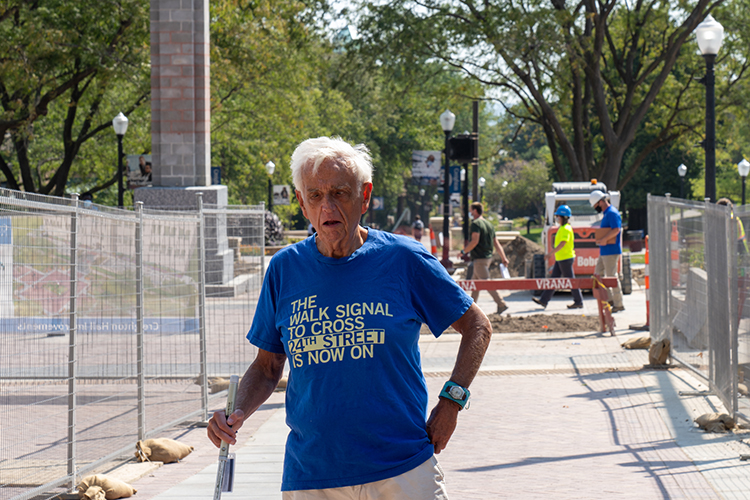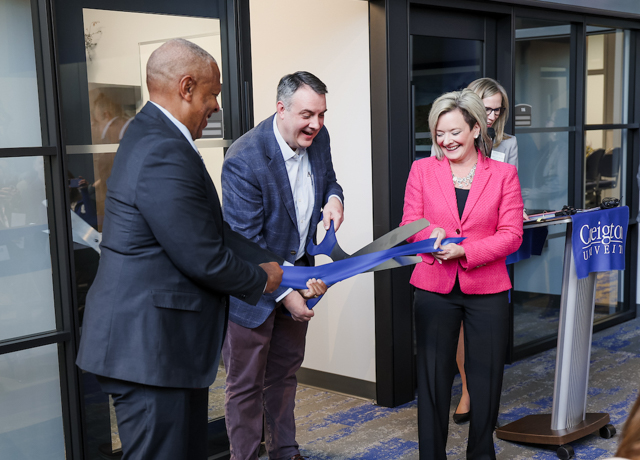Featured Testimonial About Creighton University
That poor woman was scrunched up in that little speaker box all these years. And then she'd always get cut off the third time she tried to say the walk signal is on. But I could never have crossed without the security of that sound.


Father Larry Gillick, SJ, remembers the days before the walk signal to cross 24th Street found its voice.
"There was a button to push, but no voice or other sound to let me know when to cross or how long I had," says Fr. Gillick, who is visually impaired. "I would hit the button, listen very carefully, hope the cars saw the light and then run across the street as fast as I could. I was a very fast runner then."
When 24th became a two-way street, says Fr. Gillick — director of the Deglman Center for Ignatian Spirituality — it got even tougher for him to make out where the cars were coming from, and how fast.
About 30 years ago, then-Creighton President The Rev. Michael G. Morrison, SJ, took note of his friend bolting across the street. That wouldn’t do. To accommodate both Fr. Gillick and a visually impaired law student, Creighton added to the crosswalk a voiceover of "Walk signal to cross 24th Street is now on."
For three decades, that voice safely guided him and many others to each side of the Mall. To the best of Fr. Gillick’s knowledge, campus has never had any other crosswalks with a voiceover.
"Yes, that poor woman was scrunched up in that little speaker box all these years," he says. "And then she'd always get cut off the third time she tried to say the walk signal is on. But I could never have crossed without the security of that sound."
As we noted in a previous story, the beautification of the 24th Street corridor leaves the fate of the crosswalk voice in question. New pedestrian walk signals were installed this week. The lights will beep when it's safe to cross, beeping faster as time runs out.
When Creighton installed the voice at 24th Street, audible pedestrian signals were less common. Visible pedestrian signals were first installed in the U.S. in the 1930s, and audible signals began to spread in the 1970s. In the late ’90s, Congress passed The Transportation Equity Act for the 21st Century, which directed crosswalks to include audible signals.
Derek Scott, associate vice president of Facilities Management, says they hope to add the voice back to the crosswalk, but are still determining if it complies with code and guidelines.
Whatever the case, Scott says, the safety of the crosswalk is much improved. He noted the vehicle lane reduction, separate bike lanes, dedicated bus pullouts, new pedestrian/vehicle lane markers, as well as the elimination of the vehicle drop-off in Deglman Square. The roundabout to the south, meanwhile, will slow traffic.
The project also transforms Creighton's front door and spotlights many other improvements around campus.
Fr. Gillick is very pleased, both with the safety improvements and the beautification of Creighton’s gateway. It’s a testament, he says, to how much campus has grown and flourished over his 40-plus years at Creighton.
He will miss that voice if it doesn’t return. But whatever happens, he considers this an opportunity to reflect on the nature of change and celebrate the larger transformation taking place at Creighton.
"Maybe it's time for a new voice, anyway, a new kid in town."
In fact, he says, there's perhaps no better Creighton metaphor for accepting change than the walk signal itself.
About a decade ago at a Baccalaureate Mass, Fr. Gillick gave a homily for graduating students. Beforehand, he stopped by 24th Street and grabbed a recording of the walk signal to play during his homily. All the students laughed. Most of their parents were confused.
"The signal is perfect for a graduation homily," Fr. Gillick says. "Graduation is a signal to cross, not just this 24th Street, but all the other 24th Streets you'll ever cross."


